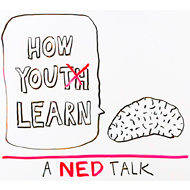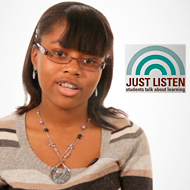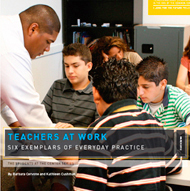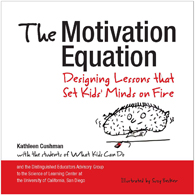
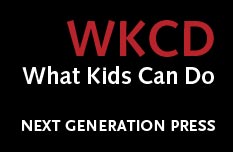
How Youth Learn: A Portfolio to Inform and Inspire Educators, Students, Parents & More
| The "Fires" Series | SHARE |
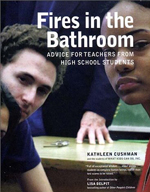 |
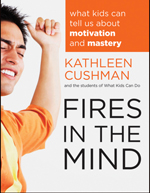 |
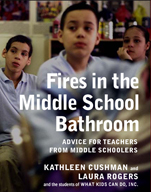 |
Early adolescents had their turn to speak out in Fires in the Middle School Bathroom, which followed in 2008. Their words give teachers a poignant picture of the unsteady ground that “tweens” negotiate as they leave childhood behind for more complicated territory ahead. Their social worlds, their personal preoccupations, and their ever-shifting energies inevitably arrive in the classroom with them, challenging their attention to the tasks of school. This book attunes teachers to the rewards of listening closely and using what we hear, as middle schoolers reveal the secrets of their developmental journey.
Youth talk about their motivation to learn throughout the Fires series, and in Fires in the Mind (2010), WKCD asked high school students to investigate that more deeply. As they described the areas where they were already “getting really good” in school and out, these youth found that their experiences closely aligned with the scientific research on the development of expertise. This book raises important questions about how classroom learning can spark the same degree of engagement and effective practice that students speak of when describing their out-of-school activities.
More WKCD books that raise youth voices:
Sent to the Principal (2006) brings the insights of high school students to the toughest job in school—the principal. Whether it’s about electives or dress codes, equity or school security, teenagers want to make school a place they care about, feel part of, and believe that they can succeed in. “Tremendous gist for the important conversations that need to take place to transform our high schools” (Education Alliance).
Just Listen: Students Talk About Teaching and Learning
How do young people really experience their own learning? It’s easy for educators to make assumptions—but often we find more authentic answers by listening closely to what students say. That is what sparked WKCD’s “Just Listen” series of video clips, in which high school students speak directly to viewers about teaching and learning. Too often, the general public perceives adolescents as apathetic and even anti-school, taking little or no interest in their own education. These videos create a different picture: they reveal that kids care about learning and appreciate adult guidance.
WKCD’s “Just Listen” series currently includes more than 200 video clips (average length one minute). The full playlist can be found at our Just Listen Channel on YouTube. Here, we present six small collections (4 clips each) of students talking about: teacher-student relationships; nurturing potential; agency and mastery; revising and questioning; self-regulation and persistence; and the role of humor, curiosity, imagation, and more in learning.
Just Listen: Students Talk About Learning
Student-Teacher Relationships (2.58 min) |
Nurturing Potential (3:13 min) |
Motivation & Mastery (5:07 min) |
Self-Regulation & Persistence (4:20 min) |
Revising & Questioning (3:52 min) |
More Reflections on Learning (4:45 min) |
Students Talk About Social-Emotional Learning
What most helps young people thrive in a challenging academic environment? Answers from students bear out what research has found: social and emotional factors constitute a crucial underpinning for learning. In this audioslideshow, middle schoolers at School of the Future in New York City give their own examples of how everyday interactions between students, peers, and adults affected how they learn in the classroom. Their descriptions reflect some key unspoken questions that adolescents bring with them into a school environment: Will I able to do the work here? Will I be smart enough? Will I be safe here? Will I be teased or made to feel bad somehow? Will I get to help decide what happens to me here?
|
I never realized how deep I am. Even other people have told me how they think I should be a writer. I’m like, “Ah. I don’t know if I really wanna do that.” But. yeah, you just find out so much about yourself, things that you wouldn’t really . . . things that you don’t even know. - Elijah |
|
How does social and emotional learning "go down" for a diverse group of Chicago high school students? Five youth from Chicago's Mikva Challenge share their thoughts and experiences on the interplay between emotions and academics in the schools they attend. The students are strikingly different from each other, but the themes they sound are shared: the importance of teacher-student relationships, the desire of students to stand out (or be invisible), the toll stereotyping takes on students, teachers, and schools. Several of the students attend once-failing high schools where social and emotional learning is part of the school's turnaround strategy. Each video is 3-5 min. long.
 |
Download discussion prompts and questions--for teachers and students--to spark reflection and debate about what these students say. |
Lisa
|
Jaquarius
|
Jack
|
|
||
Kahil
|
Raven
|
In the following six videos in our series “Case Studies in Practice” (each about 3 minutes long) middle and high school students tell how they gained proficiency in reading, math, engineering, debate, media technology, and ballroom dance.
Reading |
Math |
Robotics |
||
 |
TRY A ‘PRACTICE PROJECT’: Our 5-day curriculum has kids analyze the learning process, starting with what they already know and can do well. | |||
 |
Everything takes practice. It's not like one day you can just get up and say, 'I'm going to do something.' You got to practice at it. - Darius | |||
Debate |
Youth Radio |
Ballroom Dancing |
